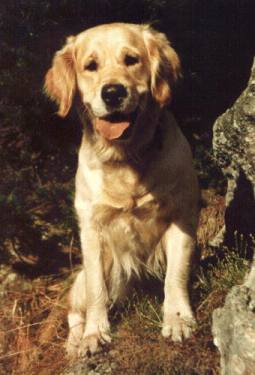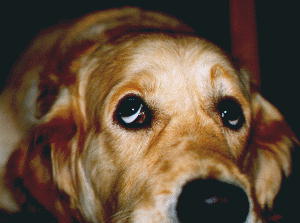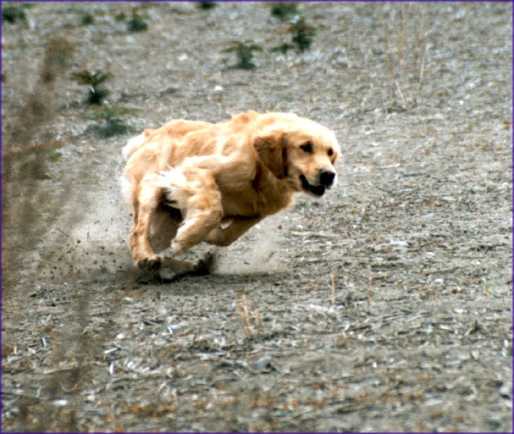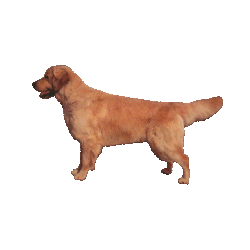

According to the FCI (Fédération Cynologique Internationale), Golden Retrievers belong to Group VIII. These dogs are mainly involved in tracking, flushing, and retrieving shot game.
General Appearance
Harmonious, active, strong, with harmonious movement; having a healthy and gentle appearance.
Characteristic Features
Easy to train, intelligent, and possessing natural retrieving abilities.
Head
Harmonious, clearly chiseled, with a broad skull; well-set on the neck, a strong, broad, and deep muzzle. The length of the muzzle is similar to the length of the skull, from the well-defined stop to the occipital prominence. A black nose is desirable.

Eyes
Dark brown, fairly wide-set, with a dark rim.
Ears
Of medium size, set roughly at the level of the eyes.
Neck
Of good length, dry, and muscular.
Front Legs
Shoulders slanting, legs straight, with strong bones, well-set under the body, their length is similar to the length of the shoulder blade with the upper arm. Elbows fitting well.

Body
Harmonious, compact, short, deep. Well-arched ribs. Harmonious top line. Loin strong and well-muscled.
Hind Legs
Strong and well-muscled legs, well-angled. Short hocks, viewed from all sides, straight. Cow-hocked stance highly undesirable.
Feet
Round, so-called “cat feet.”
Tail
Set in line with the back, reaching to the hock joint, not docked at the end, carried in line with the back when in motion.
Movement
Full of power and dynamism. Legs move straight, both front and rear. Long and free stride, without the tendency of the front legs to “hackney.”
Coat
Straight or wavy, dense, with an undercoat that provides good protection against moisture. Noticeably longer hair on the tail, front legs, chest, and thighs.
Color
All shades of golden and cream, never red or mahogany. A few white hairs on the chest are acceptable.
Size
Height at withers: males 56-61cm (22-24 inches); females 51-56cm (20-22 inches).
Faults
Any deviations from the standard are considered faults, and they are serious when their severity disrupts proportions.
Note
The dog should have two normally descended testicles.
COMMENTARY ON THE STANDARD
General Appearance
The overall appearance is equivalent to the first impression when looking at a dog. A Golden Retriever (GR) must be well-balanced in proportions. In theory, a GR should spend the whole day in motion, in varied terrain without visible effort. Therefore, it must be a strong, durable dog with impeccable construction to perform the retriever’s role well in various conditions. Harmony and balance should be evident not only in the top line and leg length but also in the positioning of the shoulder and the angulation of the hind limbs. A dog works well when it moves well, with free, fluid movement being the result of deep angulation in both the front and rear. This is a dog that is more low than high-legged, never resembling a setter in any way.

Head
The head is the element that gives expression to the breed. It should be proportional, broad, with a slightly arched skull but never ordinary. GR is a retrieving dog, which is why a strong muzzle is essential. It should not be narrow, pointed, or weak. The length of the muzzle should be similar to the length of the skull, from the well-defined stop to the occipital prominence. A well-defined stop and an arched skull are desirable. A head with a weak stop and a flat skull can resemble a Hovawart’s head, while a narrow one can resemble a Flat Coated Retriever’s head. In general, the head should be fairly large and strong. A black nose is preferred, though it can occasionally lighten, especially in winter or in females during heat and pregnancy. Complete depigmentation of the nose is very rare.
Eyes
Eyes give the GR its characteristic sweet expression, so their shape and color are crucial. They should be dark brown, not black (which spoils the expression) or light yellow. The shape of the eyes also reflects the vitality of the GR, so they should not be too small or protruding. We are looking for medium-sized, almond-shaped eyes with close-fitting eyelids (droopy eyelids are incorrect) and a dark outline, not set too narrowly.
Ears
From the profile, they should be set in line with the eyes. The placement of the ears can also influence the expression of the head. They should be of medium size; ears that are too large give the appearance typical of Basset Hounds, while ears that are too small and high-set look like they are stuck on.
Neck
When assessing a Golden Retriever, the neck and shoulders are the most important structural elements that determine balance and excellence. The neck must be of good length, muscular, allowing for good performance in uneven terrain and in water. The neck should gradually slope down to the withers, which should be clearly defined by the descending, well-set shoulders. The standard states that the neck should be dry, but in practice, it rarely occurs with a strong head and loose skin on the neck, which doesn’t affect the assessment as it might in an Irish Setter, for example.
Front Legs
The front legs should be straight, strong, with no loose elbows. The bone should be strong but not as heavy as that of a Newfoundland. This is a point in the standard where you can clearly see the difference between purely show-line dogs and purely working-line dogs; the latter tend to have lighter bones. The wrists should be strong, only slightly sloping to the ground, ending with a round, “cat-like,” very compact paw.
Shoulders – their length and placement should be such that the front legs stand freely “under the dog,” meaning the angle between the shoulder blade and the upper arm should be close to a right angle, and the length of the shoulder blade should be equal to the length of the upper arm.
Body
Once again, harmony is the key element. All components should be in good proportions, ensuring shortness and compactness to the body. However, “short” here does not mean “square” – in no way should it resemble the silhouette of a Terrier or Boxer. The GR is longer than it is tall, with a deep and far-reaching ribcage towards the rear. Therefore, a too short body is just as much of a fault as an overly long one, leading to a weak back.
For a working dog, the ribcage is crucial in determining the size and shape of the chest. An overly round chest can disrupt the movement of the front legs, causing elbows to turn out or a converging paw stance. When the ribs are too flat, the dog appears narrow and lightweight.
The loins must be strong and well-muscled. Disharmony in the body structure most often results from incorrect loin length. The correct top line and body harmony are the result of the proper positioning and proportions of all elements. An excessively deep chest gives the impression of being short-legged, while steep shoulders shorten the dog optically, but ruin the top line and movement. A tail carried too cheerfully, both in profile and from behind, also spoils the overall picture.
Hind Legs
A GR should have strong hind legs that allow for free movement and work throughout the day. Once again, excellent proportions must be accompanied by excellent angulation and bone placement. When observing the dog from the rear, the legs should be parallel, with no tendency to turn the hocks outward or inward. The hind legs should be equally well-spaced as the front legs. The standard requires good angulation of the hind legs – an overly steep rear will never allow for free, long, dynamic steps. The positioning of the pelvis and the angles between the leg bones are important here.
A Golden Retriever has a clearly defined knee; the legs should not be turned out. The hock should be moderately low-set. In practice, there is more tolerance for slightly steep rears than for steep fronts.
Movement
A GR should move with a calm, effortless trot. Good construction allows for proper movement. The stride should be long and free, without excessively lifted front legs (stepping or hackney is a fault).
Coat
The coat should be straight or wavy, never curly, with a dense undercoat providing protection against moisture. Longer hair is clearly visible on the rear side of the front legs, chest, and abdomen, forming “pants” on the thighs and “feathering” on the tail. The tail should resemble the brush of a fox rather than the tail of a Setter. Preparing a GR for a show requires similar grooming to that of Spaniels. Hair on the head, neck, paws, and tail is adjusted.


Color
Color remains one of the elements that still cause confusion today. The standard allows for all shades of cream and golden. In the first versions of the standard, only golden was mentioned, but in 1936, an amendment was introduced allowing the cream color (which was the color of the first GR specimens). However, the American GR standard does not allow for this color. Therefore, it is not correct to say that one dog has a better color than another. Red and mahogany are the only unacceptable colors. So when someone says or writes that a dog is too light, it means they have not carefully read the standard.
Size
The standard mentions heights of 56-61 cm for males and 51-56 cm for females. This is one of the more difficult elements for a judge to determine. It should be remembered, though, that a flawless, harmonious build makes it challenging to determine size, and a perfectly balanced and strong dog always appears smaller than it actually is. However, in most cases, we do not measure the dog, and it appears to us the size it looks like.
Faults
First, it should be said that flawless dogs are not born. Every dog has some faults, and the standard states that all deviations from the standard are faults, with only the degree of their severity determining their significance. What may be a bigger fault for one person might be a minor issue for others. Certainly, the overall impression, type, and movement are the most important. One should avoid judging based solely on faults, starting by looking for flaws. Sometimes a dog with the fewest faults is simply average and nothing more.
